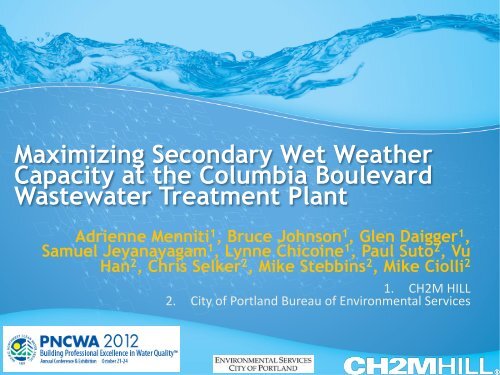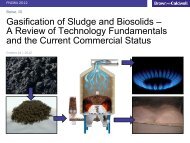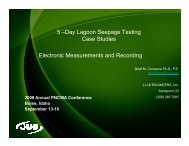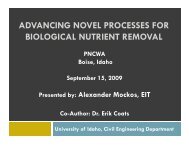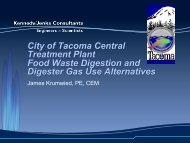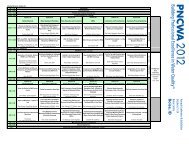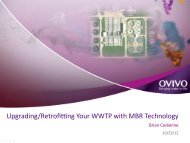Maximizing Secondary Wet Weather Treatment Capacity at ... - pncwa
Maximizing Secondary Wet Weather Treatment Capacity at ... - pncwa
Maximizing Secondary Wet Weather Treatment Capacity at ... - pncwa
Create successful ePaper yourself
Turn your PDF publications into a flip-book with our unique Google optimized e-Paper software.
<strong>Maximizing</strong> <strong>Secondary</strong> <strong>Wet</strong> <strong>We<strong>at</strong>her</strong><br />
<strong>Capacity</strong> <strong>at</strong> the Columbia Boulevard<br />
Wastew<strong>at</strong>er <strong>Tre<strong>at</strong>ment</strong> Plant<br />
Adrienne Menniti 1 , Bruce Johnson 1 , Glen Daigger 1 ,<br />
Samuel Jeyanayagam 1 , Lynne Chicoine 1 , Paul Suto 2 , Vu<br />
Han 2 , Chris Selker 2 , Mike Stebbins 2 , Mike Ciolli 2<br />
1. CH2M HILL <br />
2. City of Portland Bureau of Environmental Services
Portland Rain Fall P<strong>at</strong>terns<br />
70<br />
60<br />
We don’t get more total rain than other ciBes…. <br />
Yearly Total Rainfall (in)<br />
50<br />
40<br />
30<br />
20<br />
10<br />
0<br />
New York, NY Miami, FL Boise, ID Se<strong>at</strong>tle, WA Portland, OR<br />
Average from 1971-‐2000 d<strong>at</strong>a from NOAA <br />
2
Portland Rainfall P<strong>at</strong>terns<br />
180<br />
We get lower intensity rain more oLen <br />
150<br />
Annual Days of Rain<br />
120<br />
90<br />
60<br />
30<br />
0<br />
New York, NY Miami, FL Boise, ID Se<strong>at</strong>tle, WA Portland, OR<br />
Average from 1981-‐2010, d<strong>at</strong>a from NOAA <br />
3
Portland Rainfall P<strong>at</strong>terns<br />
Plant Influent Flow (mgd)<br />
300<br />
250<br />
200<br />
150<br />
100<br />
50<br />
Seasonal we<strong>at</strong>her paRerns transl<strong>at</strong>e to highly <br />
variable influent flows all winter long <br />
0<br />
12/25/2008 4/28/2009 8/30/2009 1/1/2010 5/5/2010 9/6/2010<br />
D<strong>at</strong>e<br />
4
Columbia Boulevard WWTP<br />
Largest wastew<strong>at</strong>er tre<strong>at</strong>ment plant in Oregon<br />
– Average Winter Flow = 90 mgd<br />
Serves 614,000 people<br />
Discharges to the Columbia River<br />
Recent CSO storage improvements covey more<br />
wet we<strong>at</strong>her flows to tre<strong>at</strong>ment plant, increasing<br />
peak flow from 300 mgd to 450 mgd<br />
5
Columbia Boulevard WWTP<br />
Dry <strong>We<strong>at</strong>her</strong> <strong>Tre<strong>at</strong>ment</strong> Train<br />
8 Parallel <br />
Aera8on Basins <br />
8 Square <br />
<strong>Secondary</strong> Clarifiers <br />
Permit <br />
Limits Monthly (mg/L) Weekly (mg/L) <br />
BOD 30 45 <br />
TSS 30 45 <br />
Includes sodium hypochlorite disinfec8on <br />
Headworks <br />
Dry <strong>We<strong>at</strong>her</strong> <br />
Primary Clarifiers <br />
6
Columbia Boulevard WWTP<br />
<strong>Wet</strong> <strong>We<strong>at</strong>her</strong> <strong>Tre<strong>at</strong>ment</strong> Train<br />
The wet we<strong>at</strong>her primary clarifiers also provide storage for excess wet we<strong>at</strong>her flow <br />
during small rain events <br />
<strong>Wet</strong> <strong>We<strong>at</strong>her</strong> <br />
Chemically Enhanced <br />
Primary Clarifiers <br />
Permit <br />
Limits Monthly (mg/L) Weekly (mg/L) <br />
BOD 45 65 <br />
TSS 45 65 <br />
<strong>Wet</strong> <strong>We<strong>at</strong>her</strong> <br />
Screening Facility <br />
Headworks <br />
Includes sodium hypochlorite disinfec8on<br />
7 <br />
<br />
7
CBWTP Aims to Maximizes Flow Receiving <strong>Secondary</strong><br />
<strong>Tre<strong>at</strong>ment</strong><br />
300<br />
Influent Flow<br />
<strong>Secondary</strong> Flow<br />
250<br />
Plant is regularly pushing<br />
secondary tre<strong>at</strong>ment capacity<br />
to achieve this goal<br />
Flow (mgd)<br />
200<br />
150<br />
100<br />
50<br />
0<br />
12/25/2008 4/28/2009 8/30/2009 1/1/2010 5/5/2010 9/6/2010<br />
D<strong>at</strong>e<br />
8
Challenges to <strong>Maximizing</strong> <strong>Secondary</strong> <strong>Tre<strong>at</strong>ment</strong><br />
1. High historical SVI values<br />
600<br />
500<br />
Design SVI = 200 mL/g<br />
SVI (mL/g)<br />
400<br />
300<br />
200<br />
100<br />
0<br />
12/25/2008 4/28/2009 8/30/2009 1/1/2010 5/5/2010 9/6/2010<br />
D<strong>at</strong>e<br />
9
Challenges to <strong>Maximizing</strong> <strong>Secondary</strong> <strong>Tre<strong>at</strong>ment</strong><br />
2. Lack of Autom<strong>at</strong>ion in <strong>Secondary</strong> Process (wasting, DO control)<br />
600<br />
SVI (mL/g)<br />
500<br />
400<br />
300<br />
200<br />
Extreme SVI excursion caused<br />
by manual wasting approach.<br />
Plant over wasted during a<br />
strong rain event, washing out<br />
selector.<br />
100<br />
0<br />
12/25/2008 4/28/2009 8/30/2009 1/1/2010 5/5/2010 9/6/2010<br />
D<strong>at</strong>e<br />
10
Challenges to <strong>Maximizing</strong> <strong>Secondary</strong> <strong>Tre<strong>at</strong>ment</strong><br />
3. Lack of <strong>Wet</strong> <strong>We<strong>at</strong>her</strong> Oper<strong>at</strong>ing Modes<br />
All the g<strong>at</strong>es along the old complete mix<br />
distribution channel must be opened manually<br />
to step feed flow on current basins<br />
11
Challenges to <strong>Maximizing</strong> <strong>Secondary</strong> <strong>Tre<strong>at</strong>ment</strong><br />
4. Poor clarifier design and performance<br />
Shallow (12.5 ft deep), square, peripheral-feed, peripheral-withdraw<br />
Effluent <br />
Feed <br />
12
Project Goals<br />
1. Maximize peak flow tre<strong>at</strong>ed through secondary<br />
process<br />
Provide wet we<strong>at</strong>her oper<strong>at</strong>ing modes<br />
2. Maintain stable oper<strong>at</strong>ion during all flow conditions<br />
Maintain well settling sludge across all oper<strong>at</strong>ing modes, provide<br />
tools to address settleability issues<br />
3. Simple oper<strong>at</strong>ion and intuitive control<br />
Decision to shift oper<strong>at</strong>ing mode is intuitive, solutions are simple<br />
and robust to oper<strong>at</strong>e<br />
4. Improve secondary clarifier performance<br />
Use CFD to evalu<strong>at</strong>e potential clarifier improvements<br />
13
Project Goals<br />
1. Maximize peak flow tre<strong>at</strong>ed through secondary<br />
process<br />
Provide wet we<strong>at</strong>her oper<strong>at</strong>ing modes<br />
14
Two Types of <strong>Wet</strong> <strong>We<strong>at</strong>her</strong> Events<br />
1. Several small to moder<strong>at</strong>e rain events with dry we<strong>at</strong>her in between<br />
400<br />
Influent Flow<br />
Plant Influent Flow (mgd)<br />
350<br />
300<br />
250<br />
200<br />
150<br />
100<br />
50<br />
0<br />
5/12 5/17 5/22 5/27 6/1 6/6 6/11 6/16<br />
Time (days)<br />
15
Two Types of <strong>Wet</strong> <strong>We<strong>at</strong>her</strong> Events<br />
2. Long rain events th<strong>at</strong> fills the CSO storage tunnels<br />
300<br />
Influent Flow<br />
Plant Influent Flow (mgd)<br />
250<br />
200<br />
150<br />
100<br />
50<br />
Completion of CSO storage tunnel project<br />
in Nov. 2011 increased peak and dur<strong>at</strong>ion<br />
0<br />
3/28 3/29 3/30 3/31 4/1 4/2<br />
Time (days)<br />
16
Two <strong>Wet</strong> <strong>We<strong>at</strong>her</strong> Oper<strong>at</strong>ing Modes<br />
Step feed is the normal oper<strong>at</strong>ing mode<br />
RAS<br />
1 2 3 4 5 6 7<br />
65% 35%<br />
To <strong>Secondary</strong><br />
Clarifiers<br />
RAS<br />
1 2 3 4<br />
5<br />
6<br />
7<br />
To <strong>Secondary</strong><br />
Clarifiers<br />
Aerobic RAS Storage<br />
Primary Effluent<br />
Pipe Bridge<br />
Anaerobic<br />
Anaerobic/aerobic swing<br />
Aerobic<br />
<strong>Wet</strong> we<strong>at</strong>her maximum month tre<strong>at</strong>ment capacity = 98 mgd<br />
with 40% clarifier der<strong>at</strong>ing factor<br />
17
Two <strong>Wet</strong> <strong>We<strong>at</strong>her</strong> Oper<strong>at</strong>ing Modes<br />
<strong>Wet</strong> <strong>We<strong>at</strong>her</strong> Step feed is provided for use during small to medium rain events<br />
• Constant flow maintained to zone 1<br />
• Remaining flow pushed to zone 6<br />
• Avoids an oper<strong>at</strong>ing mode shift for typical rain events<br />
RAS<br />
Adjustable set point<br />
1 2 3 4 5 6 7<br />
Remaining Flow<br />
To <strong>Secondary</strong><br />
Clarifiers<br />
RAS<br />
1 2 3 4<br />
5<br />
6<br />
7<br />
To <strong>Secondary</strong><br />
Clarifiers<br />
Aerobic RAS Storage<br />
Primary Effluent<br />
Pipe Bridge<br />
Anaerobic<br />
Anaerobic/aerobic swing<br />
Aerobic<br />
<strong>Wet</strong> we<strong>at</strong>her maximum month tre<strong>at</strong>ment capacity = 110 mgd<br />
with 40% clarifier der<strong>at</strong>ing factor<br />
18
Two <strong>Wet</strong> <strong>We<strong>at</strong>her</strong> Oper<strong>at</strong>ing Modes<br />
Step feed with RAS Storage is provided for use during large rain events<br />
• Upstream feed point shifted to zone 2<br />
• Provides storage of RAS to protect inventory from washout<br />
• Further reduces clarifier solids loading r<strong>at</strong>e<br />
RAS<br />
1 2 3 4 5 6 7<br />
65% 35%<br />
To <strong>Secondary</strong><br />
Clarifiers<br />
RAS<br />
1 2 3 4<br />
5<br />
6<br />
7<br />
To <strong>Secondary</strong><br />
Clarifiers<br />
Aerobic RAS Storage<br />
Primary Effluent<br />
Pipe Bridge<br />
Anaerobic<br />
Anaerobic/aerobic swing<br />
Aerobic<br />
<strong>Wet</strong> we<strong>at</strong>her maximum month tre<strong>at</strong>ment capacity = 116 mgd<br />
with 40% clarifier der<strong>at</strong>ing factor<br />
19
Project Goals<br />
1. Maximize peak flow tre<strong>at</strong>ed through secondary<br />
process<br />
Provide wet we<strong>at</strong>her oper<strong>at</strong>ing modes<br />
2. Maintain stable oper<strong>at</strong>ion during all flow conditions<br />
Maintain well settling sludge across all oper<strong>at</strong>ing modes, provide<br />
tools to address settleability issues<br />
20
Maintain Well Settling Sludge<br />
Two types of selectors provided:<br />
Anaerobic selector <strong>at</strong> Zones 1 and 2<br />
Aerobic selector <strong>at</strong> Zone 6<br />
RAS<br />
1 2 3 4 5 6 7<br />
65% 35%<br />
To <strong>Secondary</strong><br />
Clarifiers<br />
RAS<br />
1 2 3 4<br />
5<br />
6<br />
7<br />
To <strong>Secondary</strong><br />
Clarifiers<br />
Aerobic RAS Storage<br />
Primary Effluent<br />
Encourages PAO growth to<br />
remove soluble BOD<br />
anaerobically.<br />
Pipe Bridge<br />
Small, baffled zone cre<strong>at</strong>es<br />
high F:M, encouraging rapid<br />
uptake and storage of soluble<br />
BOD by heterotrophs<br />
Anaerobic<br />
Anaerobic/aerobic swing<br />
Aerobic<br />
21
Maintain Well Settling Sludge<br />
Autom<strong>at</strong>ed SRT control incorpor<strong>at</strong>ed into design to avoid<br />
washing out anaerobic selector<br />
RAS<br />
TSS Probe<br />
RAS BOX<br />
WAS<br />
TSS Probe<br />
TSS Probe<br />
RAS<br />
1 2 3 4 5 6 7<br />
65% 35%<br />
To <strong>Secondary</strong><br />
Clarifiers<br />
RAS<br />
1 2 3 4<br />
5<br />
6<br />
7<br />
To <strong>Secondary</strong><br />
Clarifiers<br />
TSS Probe<br />
TSS Probe<br />
Aerobic RAS Storage<br />
Primary Effluent<br />
Pipe Bridge<br />
Anaerobic<br />
Anaerobic/aerobic swing<br />
Aerobic<br />
22
Provide Tools for Sludge Settleability Control<br />
Highly oxygen<strong>at</strong>ed wet we<strong>at</strong>her flows can disrupt the anaerobic zone<br />
RAS<br />
1 2 3 4 5 6 7<br />
65% 35%<br />
To <strong>Secondary</strong><br />
Clarifiers<br />
RAS<br />
1 2 3 4<br />
5<br />
6<br />
7<br />
To <strong>Secondary</strong><br />
Clarifiers<br />
Aerobic RAS Storage<br />
Primary Effluent<br />
Anaerobic/aerobic swing zone<br />
maintains sufficient anaerobic<br />
SRT under these conditions<br />
Pipe Bridge<br />
Anaerobic<br />
Anaerobic/aerobic swing<br />
Aerobic<br />
23
Provide Tools for Sludge Settleability Control<br />
Influent VFAs can decrease during wet we<strong>at</strong>her making<br />
selector difficult to maintain<br />
RAS<br />
1 2 3 4 5 6 7<br />
65% 35%<br />
To <strong>Secondary</strong><br />
Clarifiers<br />
RAS<br />
1 2 3 4<br />
5<br />
6<br />
7<br />
To <strong>Secondary</strong><br />
Clarifiers<br />
Aerobic RAS Storage<br />
Primary Effluent<br />
Pipe Bridge<br />
Anaerobic<br />
Anaerobic/aerobic swing<br />
Aerobic RAS storage zone can be<br />
intermittently aer<strong>at</strong>ed to increase VFA<br />
production during long rain events<br />
Thanks to Dr. David Stensel for this idea!<br />
Aerobic<br />
24
Project Goals<br />
1. Maximize peak flow tre<strong>at</strong>ed through secondary<br />
process<br />
Provide wet we<strong>at</strong>her oper<strong>at</strong>ing modes<br />
2. Maintain stable oper<strong>at</strong>ion during all flow conditions<br />
Maintain well settling sludge across all oper<strong>at</strong>ing modes, provide<br />
tools to address settleability issues<br />
3. Simple oper<strong>at</strong>ion and intuitive control<br />
Decision to shift oper<strong>at</strong>ing mode is intuitive, solutions are simple<br />
and robust to oper<strong>at</strong>e<br />
25
Decision to Shift Oper<strong>at</strong>ing Mode is Intuitive<br />
During wet we<strong>at</strong>her events, plant staff set flow r<strong>at</strong>e to secondary process<br />
Plant Influent<br />
<strong>Secondary</strong> Influent<br />
400<br />
350<br />
300<br />
Flow (mgd)<br />
250<br />
200<br />
150<br />
100<br />
50<br />
0<br />
0 5 10 15 20 25 30 35 40<br />
MLSS Inventory<br />
Time (days)<br />
<strong>Secondary</strong> Process BOD Loading<br />
26
Decision to Shift Oper<strong>at</strong>ing Mode is Intuitive<br />
The maximum flow r<strong>at</strong>e to Zone 1 is also an oper<strong>at</strong>or set point. Excess flow is<br />
autom<strong>at</strong>ically directed to Zone 6 of each basin.<br />
So, oper<strong>at</strong>ors don’t need to initi<strong>at</strong>e the change to wet we<strong>at</strong>her step feed.<br />
Shift to Step Feed with RAS Storage is manually initi<strong>at</strong>ed but<br />
autom<strong>at</strong>ically executed<br />
RAS<br />
Adjustable set point<br />
1 2 3 4 5 6 7<br />
Remaining Flow<br />
To <strong>Secondary</strong><br />
Clarifiers<br />
RAS<br />
1 2 3 4<br />
5<br />
6<br />
7<br />
To <strong>Secondary</strong><br />
Clarifiers<br />
Aerobic RAS Storage<br />
Primary Effluent<br />
Pipe Bridge<br />
Anaerobic<br />
Anaerobic/aerobic swing<br />
Aerobic<br />
27
Additional Tools to Maximize <strong>Secondary</strong> <strong>Tre<strong>at</strong>ment</strong><br />
Instrument<strong>at</strong>ion provided for SRT and stepfeed control allows tracking of<br />
clarifier solids loading r<strong>at</strong>e<br />
Channel Flow<br />
Meter<br />
RAS<br />
TSS Probe<br />
1 2 3 4 5 6 7<br />
65% 35%<br />
To <strong>Secondary</strong><br />
Clarifiers<br />
RAS<br />
1 2 3 4<br />
5<br />
6<br />
7<br />
To <strong>Secondary</strong><br />
Clarifiers<br />
Channel Flow<br />
Meter<br />
Primary Effluent<br />
Channel Flow<br />
Meter<br />
Pipe Bridge<br />
TSS Probe<br />
Aerobic RAS Storage<br />
Anaerobic<br />
Anaerobic/aerobic swing<br />
Aerobic<br />
Long term experience may allow an autom<strong>at</strong>ed control str<strong>at</strong>egy to adjust the<br />
secondary process flow based on clarifier solids loading r<strong>at</strong>e<br />
28
Project Goals<br />
1. Maximize peak flow tre<strong>at</strong>ed through secondary<br />
process<br />
Provide wet we<strong>at</strong>her oper<strong>at</strong>ing modes<br />
2. Maintain stable oper<strong>at</strong>ion during all flow conditions<br />
Maintain well settling sludge across all oper<strong>at</strong>ing modes, provide<br />
tools to address settleability issues<br />
3. Simple oper<strong>at</strong>ion and intuitive control<br />
Decision to shift oper<strong>at</strong>ing mode is intuitive, solutions are simple<br />
and robust to oper<strong>at</strong>e<br />
4. Improve secondary clarifier performance<br />
Use CFD to evalu<strong>at</strong>e potential clarifier improvements<br />
29
Clarifier Assessment Approach<br />
1. Use historical d<strong>at</strong>a to understand clarifier<br />
performance<br />
2. Perform clarifier stress testing to calibr<strong>at</strong>e CFD<br />
model<br />
3. Use CFD to determine clarifier failure mechanism<br />
4. Evalu<strong>at</strong>e potential improvements using CFD<br />
30
Clarifier <strong>Capacity</strong> Analysis Based on Historical D<strong>at</strong>a<br />
March 2010 Rain Event Allowed Historical Stress Testing<br />
<strong>Secondary</strong> Flow R<strong>at</strong>e <br />
Blanket Depth <br />
<strong>Secondary</strong> Flow R<strong>at</strong>e (MGD)<br />
160<br />
140<br />
120<br />
100<br />
80<br />
60<br />
40<br />
20<br />
0<br />
Peak flow event provided consistent<br />
secondary flow for 3 days<br />
3/26/2010 3/27/2010 3/28/2010 3/29/2010 3/30/2010 3/31/2010 4/1/2010 4/2/2010 4/3/2010<br />
Blanket Depth (ft)<br />
4.5<br />
4.0<br />
3.5<br />
3.0<br />
2.5<br />
2.0<br />
1.5<br />
1.0<br />
0.5<br />
0.0<br />
Clarifier blanket meters show a strong<br />
increase in blanket depth during storm<br />
3/26/2010 3/27/2010 3/28/2010 3/29/2010 3/30/2010 3/31/2010 4/1/2010 4/2/2010 4/3/2010<br />
31
Clarifier <strong>Capacity</strong> Analysis Based on Historical D<strong>at</strong>a<br />
March 2010 Rain Event Allowed Historical Stress Testing<br />
7.0<br />
15 3/27/2010 3/28/2010 3/29/2010 3/30/2010 3/31/2010 4/1/2010<br />
3/27/2010 SVI = 205 mL/g<br />
6.0<br />
Blanket Depth (ft)<br />
5.0<br />
4.0<br />
3.0<br />
2.0<br />
1.0<br />
0.0<br />
0.0 2.0 4.0 6.0 8.0 10.0 12.0 14.0 16.0 18.0 20.0<br />
Clarifier SLR (ppd/sf)<br />
32
Clarifier <strong>Capacity</strong> Analysis Based on Historical D<strong>at</strong>a<br />
March 2010 Rain Event Allowed Historical Stress Testing<br />
7.0<br />
6.0<br />
3/27/2010 SVI = 205 mL/g<br />
3/28/2010 SVI = 202 mL/g<br />
15 3/27/2010 3/28/2010 3/29/2010 3/30/2010 3/31/2010 4/1/2010<br />
Blanket Depth (ft)<br />
5.0<br />
4.0<br />
3.0<br />
2.0<br />
1.0<br />
0.0<br />
0.0 2.0 4.0 6.0 8.0 10.0 12.0 14.0 16.0 18.0 20.0<br />
Clarifier SLR (ppd/sf)<br />
33
Clarifier <strong>Capacity</strong> Analysis Based on Historical D<strong>at</strong>a<br />
March 2010 Rain Event Allowed Historical Stress Testing<br />
7.0<br />
6.0<br />
15 3/27/2010 3/28/2010 3/29/2010 3/30/2010 3/31/2010 4/1/2010<br />
3/27/2010 SVI = 205 mL/g<br />
3/28/2010 SVI = 202 mL/g<br />
Blanket Depth (ft)<br />
5.0<br />
4.0<br />
3.0<br />
2.0<br />
1.0<br />
0.0<br />
0.0 2.0 4.0 6.0 8.0 10.0 12.0 14.0 16.0 18.0 20.0<br />
Clarifier SLR (ppd/sf)<br />
34
Clarifier <strong>Capacity</strong> Analysis Based on Historical D<strong>at</strong>a<br />
March 2010 Rain Event Allowed Historical Stress Testing<br />
7.0<br />
6.0<br />
15 3/27/2010 3/28/2010 3/29/2010 3/30/2010 3/31/2010 4/1/2010<br />
3/27/2010 SVI = 205 mL/g<br />
3/28/2010 SVI = 202 mL/g<br />
3/29/2010 SVI = 213 mL/g<br />
Blanket Depth (ft)<br />
5.0<br />
4.0<br />
3.0<br />
2.0<br />
Solids flux analysis - the clarifiers failed <strong>at</strong> a<br />
point 40% less than the theoretical capacity<br />
1.0<br />
0.0<br />
0.0 2.0 4.0 6.0 8.0 10.0 12.0 14.0 16.0 18.0 20.0<br />
Clarifier SLR (ppd/sf)<br />
35
Clarifier Failure Mechanism<br />
Failure exacerb<strong>at</strong>ed <strong>at</strong> high SVI because the sludge blanket is less dense<br />
At failure, dispersed layer extends<br />
throughout clarifier and outlet<br />
arrangement carries TSS over weir<br />
` <br />
The turbulence<br />
cre<strong>at</strong>es a dispersed<br />
sludge layer above<br />
the thick blanket <strong>at</strong><br />
high flows<br />
Influent flow jets into<br />
the sludge blanket<br />
36
Clarifier Failure Mechanism<br />
Also used CFD to define clarifier capacity<br />
Effluent TSS (mg/L)<br />
400<br />
350<br />
300<br />
250<br />
200<br />
150<br />
100<br />
50<br />
Solids flux analysis with CFD results - the<br />
clarifiers failed <strong>at</strong> a point 20% less than the<br />
theoretical capacity<br />
The design is flexible enough to<br />
accommod<strong>at</strong>e higher clarifier capacity<br />
0<br />
10 12 14 16 18 20 22<br />
Clarifier Solids Loading R<strong>at</strong>e (ppd/sf)<br />
37
Clarifier Improvements<br />
Examined Modified Baffle Design<br />
Original baffle arrangement<br />
Modified baffle arrangement<br />
Effluent <br />
Effluent <br />
Avoids upflow<br />
cre<strong>at</strong>ed by inlet<br />
Feed <br />
Feed <br />
Protects sludge<br />
blanket from influent<br />
energy<br />
38
Clarifier Improvements<br />
Failure mechanism the same with modified baffle<br />
Effluent TSS (mg/L)<br />
180<br />
150<br />
120<br />
90<br />
60<br />
Original Baffle<br />
Modified Baffle<br />
Modified baffle doesn’t increase capacity, it reduces the<br />
severity of clarifier failure<br />
No modific<strong>at</strong>ions to secondary clarifiers in<br />
this project<br />
30<br />
0<br />
Pre-failure<br />
At failure<br />
39
Conclusion<br />
1. Project is currently under construction and will come<br />
online by June of 2014<br />
2. CFD helped us understand clarifier failure mechanism<br />
but no cost effective improvements found<br />
3. <strong>Wet</strong> we<strong>at</strong>her flows receiving secondary tre<strong>at</strong>ment will<br />
be maximized by:<br />
– Incorpor<strong>at</strong>ing step feed for normal oper<strong>at</strong>ion and two wet we<strong>at</strong>her<br />
oper<strong>at</strong>ing modes<br />
– Addressing sludge settleability issues and providing tools to<br />
maintain well settling sludge<br />
– Implementing a high degree of autom<strong>at</strong>ion to accommod<strong>at</strong>e the<br />
highly dynamic winter time flows and simplify tre<strong>at</strong>ment plant<br />
oper<strong>at</strong>ion<br />
40
Thank You!<br />
Questions<br />
Contact InformaBon <br />
adrienne.menniti@ch2m.com
St<strong>at</strong>e Point Analysis to Define Clarifier <strong>Capacity</strong><br />
Solids Loading R<strong>at</strong>e <br />
30<br />
25<br />
= 25.9 ppd/L 2 20<br />
Slope = -‐ RAS r<strong>at</strong>e = 40 MGD <br />
15<br />
10<br />
Depends on SVI <br />
Mass Flux R<strong>at</strong>e, lbs/day/ft2<br />
5<br />
Slope = overflow r<strong>at</strong>e = 1,000 gpd/<br />
L 2 <br />
SVI = 205 mL/g <br />
Ideal Clarifier <br />
Q inf = 125 MGD <br />
MLSS = 2,350 mg/L <br />
SVI = 205 mL/g <br />
RAS = 40 MGD <br />
SLR = 25.9 ppd/L 2 <br />
0<br />
0 2,000 4,000 6,000 8,000 10,000 12,000 14,000 16,000<br />
Concentr<strong>at</strong>ion, mg/L<br />
30<br />
25<br />
Solids flux analysis - the clarifiers failed <strong>at</strong> a<br />
point 40% less than the theoretical capacity<br />
20<br />
15<br />
= 15.2 ppd/L 2 <br />
Solids Loading R<strong>at</strong>e <br />
Mass Flux R<strong>at</strong>e, lbs/day/ft2<br />
10<br />
5<br />
40% deraBng <br />
Q inf = 125 MGD <br />
MLSS = 1,380 mg/L <br />
SVI = 205 mL/g <br />
RAS = 40 MGD <br />
SLR = 15.2 ppd/L 2 <br />
0<br />
0 2,000 4,000 6,000 8,000 10,000 12,000 14,000 16,000<br />
Concentr<strong>at</strong>ion, mg/L


